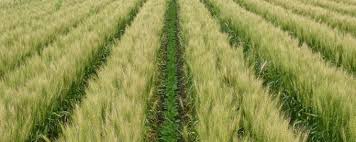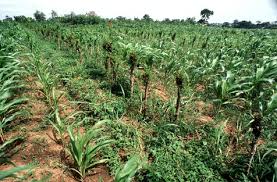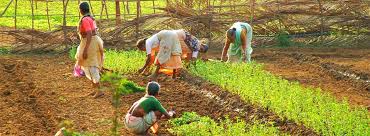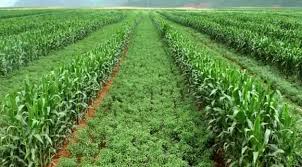Benefits of intercropping systems are numerous and significant, contributing to more sustainable and productive agricultural practices. Intercropping involves growing two or more crops in proximity during a growing season.
This method enhances biodiversity and optimizes the use of resources in various ways. One of the primary advantages of intercropping is improved resource utilization. Different crops often have varying root depths and nutrient requirements, allowing them to access different soil layers and utilize sunlight more effectively.
For example, deep-rooted crops can access moisture and nutrients from lower soil layers while shallow-rooted crops benefit from nutrients available in the upper layers. This synergy between crops leads to increased yields compared to monocropping, where only a single crop is grown.
Another significant benefit of intercropping is pest and disease management. Growing diverse crops can help reduce the spread of pests and diseases that often target specific plant types. The presence of multiple crops creates a less favorable environment for pests, making it harder for them to locate their preferred hosts.
Additionally, some plants can repel pests or attract beneficial insects that prey on harmful species. This natural pest control can decrease the reliance on chemical pesticides, promoting a healthier ecosystem and reducing costs for farmers.
Intercropping systems also enhance soil health and fertility. Different crops contribute various organic materials to the soil through their root systems and residues, improving soil structure and nutrient content. For instance, legumes, when intercropped with cereals, can fix atmospheric nitrogen, enriching the soil and benefiting neighboring crops.
Improved soil health leads to increased microbial activity, which plays a crucial role in nutrient cycling and soil fertility. Healthy soils are more resilient to erosion and degradation, further supporting sustainable agricultural practices.
Moreover, intercropping can lead to better water management. Different crops often have varying water requirements and root structures, allowing them to utilize available water resources more efficiently.
This reduces water stress on individual plants and can lead to better crop performance during periods of drought or irregular rainfall. By maximizing water use efficiency, intercropping contributes to more resilient farming systems, especially in regions facing water scarcity.
Intercropping systems also promote biodiversity, which is essential for maintaining ecosystem balance. Increased plant diversity supports a wide range of organisms, from pollinators to soil microorganisms, creating a more robust and resilient agricultural system. This biodiversity can lead to greater ecosystem services, such as improved pollination, pest control, and nutrient cycling, all of which are vital for sustainable agriculture.
Economically, intercropping can provide farmers with a diversified income stream. By growing multiple crops, farmers can reduce the risk associated with market fluctuations for a single crop.
If one crop fails due to pests, diseases, or adverse weather conditions, other crops may still thrive, ensuring some level of financial stability. This diversification can also open new markets and opportunities for farmers, making their operations more profitable in the long run.
Enhanced Biodiversity

1. Increased Ecosystem Resilience: Enhanced biodiversity in agricultural systems promotes ecosystem resilience, allowing farms to better withstand environmental changes such as climate fluctuations, pests, and diseases. Diverse plant and animal species can contribute to a more balanced ecosystem, reducing vulnerability.
2. Improved Pollination: A variety of flowering plants attracts a broader range of pollinators, such as bees and butterflies. This results in better pollination of crops, leading to higher yields and improved fruit and seed quality.
3. Natural Pest Control: Biodiversity helps maintain natural predators of pests. For instance, the presence of birds, beneficial insects, and other wildlife can keep pest populations in check, reducing the need for chemical pesticides.
4. Habitat Creation: Diverse agricultural landscapes create habitats for various species, supporting wildlife populations and enhancing the overall ecological balance. This can lead to increased predator-prey dynamics, which benefit both agriculture and conservation.
5. Genetic Diversity: Cultivating a range of crops ensures genetic diversity, which is crucial for food security. Diverse genetic resources can help develop new varieties that are more resilient to pests, diseases, and changing climate conditions.
Improved Soil Fertility
1. Organic Matter Addition: Practices like cover cropping and composting enrich the soil with organic matter, improving its structure and fertility. Organic matter enhances nutrient retention, water-holding capacity, and microbial activity, all vital for healthy soil.
2. Nutrient Cycling: Diverse cropping systems facilitate nutrient cycling, where different plants contribute to the replenishment of soil nutrients. For example, legumes can fix nitrogen in the soil, reducing the need for synthetic fertilizers.
3. Enhanced Microbial Activity: Healthy soils with diverse plant roots support a rich microbial community, which is essential for nutrient breakdown and availability. Microorganisms play a key role in decomposing organic matter and recycling nutrients for plant uptake.
4. Reduced Soil Erosion: Improved soil structure and cover from diverse crops help reduce erosion. Healthy soils can better absorb rainfall, minimizing runoff and maintaining soil fertility by preventing nutrient loss.
5. pH Balance Maintenance: Diverse plant species can contribute to balancing soil pH levels, which is crucial for nutrient availability. Certain plants can help neutralize acidic or alkaline soils, creating a more favorable environment for crops.
Pest and Disease Management
1. Crop Rotation: Implementing crop rotation disrupts the life cycles of pests and diseases, reducing their prevalence in the soil. By alternating crops, farmers can minimize the buildup of pathogens and pests associated with specific plants.
2. Companion Planting: Certain plant combinations can naturally repel pests or attract beneficial insects. For example, planting marigolds alongside vegetables can deter nematodes and other pests, promoting healthier crops.
3. Biological Control: Utilizing natural predators or pathogens to control pest populations reduces reliance on chemical pesticides. Introducing beneficial insects, such as ladybugs or lacewings, can help manage aphid populations effectively.
4. Disease Resistance: Selecting and breeding crop varieties that are resistant to specific diseases can significantly reduce losses. Diverse cropping systems allow for better integration of these resistant varieties, enhancing overall crop health.
5. Monitoring and Integrated Pest Management (IPM): Regular monitoring of pest and disease levels, combined with a holistic approach to pest control, allows for timely interventions. This strategy minimizes chemical use while effectively managing agricultural challenges.
Efficient Use of Resources
1. Water Conservation: Implementing practices like mulching, drip irrigation, and rainwater harvesting maximizes water efficiency. Diverse crop systems can also improve water infiltration and reduce evaporation, ensuring better moisture retention.
2. Nutrient Efficiency: A variety of crops can optimize nutrient uptake and reduce fertilizer inputs. By planting crops with different root structures and nutrient requirements, farmers can enhance soil nutrient availability and minimize waste.
3. Labor Optimization: Diversified farms can utilize labor more efficiently by distributing work across various crops and practices. This reduces labor peaks during harvest and allows for continuous work throughout the growing season.
4. Energy Efficiency: Sustainable practices, such as using renewable energy sources and reducing machinery use, can lead to more efficient energy consumption on the farm. Crop diversity can also minimize the need for chemical inputs, lowering overall energy costs.
5. Economic Viability: Efficient resource use leads to reduced operational costs and improved profitability. By maximizing inputs like water, nutrients, and labor, farmers can enhance their economic sustainability while promoting environmental health.
Read Also: 15 Medicinal Health Benefits Of Apocynum androsaemifolium (Spreading Dogbane)
Increased Crop Yields

1. Improved Genetic Diversity: Increased crop yields are often achieved through the cultivation of genetically diverse crops. This diversity can lead to better adaptation to environmental stresses, such as drought or disease, enhancing overall productivity.
2. Enhanced Soil Health: Practices that promote soil health, such as cover cropping and organic matter addition, directly contribute to increased yields. Healthy soils support stronger root systems, better nutrient uptake, and improved water retention, all of which boost crop performance.
3. Precision Agriculture Techniques: Utilizing technology such as GPS, sensors, and data analytics enables farmers to apply inputs more precisely. This targeted approach to planting, watering, and fertilizing can lead to significant increases in crop yields by optimizing growth conditions.
4. Integrated Pest Management: By managing pests through a combination of biological, cultural, and chemical methods, farmers can reduce crop losses. Healthy crops are less susceptible to pest damage, which translates into higher yields at harvest.
5. Optimal Planting Practices: Techniques such as crop rotation and intercropping can lead to increased yields. These practices enhance resource use efficiency, promote better plant health, and help mitigate the risks associated with monoculture farming.
Better Nutrient Management
1. Soil Testing and Analysis: Regular soil testing helps farmers understand nutrient levels and pH, enabling them to apply fertilizers effectively. This targeted approach minimizes nutrient waste and enhances crop health.
2. Use of Organic Fertilizers: Incorporating organic fertilizers, such as compost or manure, improves soil fertility over time. Organic matter not only provides nutrients but also enhances soil structure and microbial activity, leading to better nutrient retention.
3. Cover Crops and Green Manures: Planting cover crops can help improve nutrient cycling by fixing nitrogen and adding organic matter to the soil. When tilled into the soil, these crops contribute to nutrient availability for subsequent crops.
4. Precision Nutrient Application: Employing precision agriculture techniques allows farmers to apply fertilizers at the right time and in the right amounts. This practice reduces nutrient runoff and enhances plant uptake, leading to better overall crop health.
5. Crop Rotation for Nutrient Balance: Different crops have varying nutrient requirements and contributions to soil fertility. Rotating crops helps balance nutrient levels in the soil and prevents nutrient depletion, ensuring long-term agricultural sustainability.
Reduced Soil Erosion
1. Ground Cover and Vegetation: Maintaining ground cover through cover crops, mulch, or permanent vegetation helps protect the soil from erosion caused by wind and water. This cover acts as a barrier, reducing the impact of rainfall and preventing soil displacement.
2. Contour Farming: Implementing contour farming practices, where crops are planted along the contours of the land, slows water runoff and reduces soil erosion. This technique promotes water retention and encourages infiltration into the soil.
3. Terracing: In sloped areas, terracing creates flat areas for farming, which minimizes soil erosion by reducing runoff speed. This method allows for more effective water management and enhances soil stability.
4. Reduced Tillage Practices: Conservation tillage methods, which disturb the soil less, help maintain soil structure and organic matter. These practices reduce erosion by keeping soil particles intact and promoting moisture retention.
5. Vegetative Buffers and Windbreaks: Planting trees or shrubs around fields can act as windbreaks, reducing wind erosion. Additionally, vegetative buffers along waterways help trap sediments and pollutants, protecting the soil and maintaining water quality.
Economic Advantages
1. Increased Profitability: Higher crop yields and better resource management lead to increased profitability for farmers. When crops thrive due to optimal practices, farmers can sell more produce, directly boosting their income.
2. Cost Savings: Sustainable practices often lead to cost savings in the long run. For instance, using organic fertilizers or integrated pest management can reduce dependence on expensive chemical inputs, lowering overall production costs.
3. Access to New Markets: Implementing sustainable practices can open doors to new markets, particularly those that focus on organic or eco-friendly products. Consumers increasingly seek sustainably produced goods, providing farmers with additional revenue streams.
4. Job Creation: Sustainable agriculture practices can create job opportunities within local communities. From farming to processing and distribution, sustainable practices require labor, contributing to local economies and livelihoods.
5. Long-term Viability: By focusing on economic sustainability, farmers can ensure their practices remain viable for future generations. Sustainable agriculture conserves resources and maintains productivity over time, securing long-term financial stability.
Read Also: 15 Medicinal Health Benefits Of Galium odoratum (Sweet woodruff)
Sustainable Agriculture Practices

1. Crop Rotation: Alternating different crops in a sequence helps improve soil fertility and reduces pest populations. This practice promotes biodiversity and minimizes the risk of soil depletion.
2. Organic Farming: Utilizing organic methods reduces reliance on synthetic pesticides and fertilizers. Organic farming enhances soil health, promotes biodiversity, and produces food without harmful chemicals, benefiting both the environment and human health.
3. Conservation Tillage: Minimizing soil disturbance helps maintain soil structure and health. Conservation tillage reduces erosion, improves water retention, and promotes microbial activity, leading to healthier crops and sustainable land use.
4. Integrated Pest Management (IPM): This approach combines biological, cultural, and chemical practices to manage pests effectively. IPM minimizes environmental impact and promotes ecosystem balance while protecting crops.
5. Water Conservation Techniques: Implementing practices such as drip irrigation and rainwater harvesting helps optimize water use. These techniques reduce waste and ensure sustainable water management in agricultural practices.
Climate Resilience
1. Drought Resistance: Climate-resilient crops are bred to withstand extreme weather conditions, such as droughts. These crops can maintain productivity despite challenging conditions, ensuring food security even during adverse climate events.
2. Soil Health Management: Maintaining healthy soils increases resilience to climate variability. Healthy soils can retain moisture, support diverse plant life, and withstand heavy rains or droughts, making agriculture more adaptable to changing climates.
3. Diversification of Crops: Growing a variety of crops enhances resilience against climate-related risks. If one crop fails due to climate impacts, others may thrive, ensuring a stable food supply and income for farmers.
4. Agroforestry Practices: Integrating trees into agricultural systems can improve resilience to climate change. Trees provide shade, enhance soil health, and protect against wind erosion, creating a more stable agricultural environment.
5. Adaptive Management Strategies: Implementing adaptive management involves regularly assessing and adjusting practices based on changing climate conditions. This proactive approach allows farmers to respond effectively to climate variability and maintain productivity.
Do you have any questions, suggestions, or contributions? If so, please feel free to use the comment box below to share your thoughts. We also encourage you to kindly share this information with others who might benefit from it. Since we can’t reach everyone at once, we truly appreciate your help in spreading the word. Thank you so much for your support and for sharing!
Read Also: 25 Easy Steps on How to Create a Positive Work Culture

